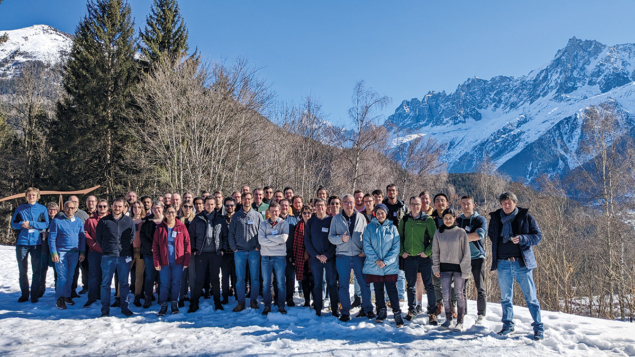
The first edition of the International Workshop on the Origin of Matter–Antimatter Asymmetry (CP2023), hosted by École de Physique des Houches, took place from 12 to 17 February. Around 50 physicists gathered to discuss the central problem connecting particle physics and cosmology: CP violation. Since one of the very first schools dedicated to time-reversal symmetry in the summer of 1952, chaired by Wolfgang Pauli, research has progressed significantly, especially with the formulation by Sakharov of the conditions necessary to produce the observed matter–antimatter asymmetry in the universe.
The workshop programme covered current and future experimental projects to probe the Sakharov conditions: collider measurements of CP violation (LHCb, Belle II, FCC-ee), searches for electric dipole moments (PSI, FNAL), long-baseline neutrino experiments (NOvA, DUNE, T2K, Hyper-Kamiokande, ESSnuSB) and searches for baryon- and lepton-number violating processes such as neutrinoless double beta decay (GERDA, CUORE, CUPID-Mo, KamLAND-Zen, EXO-200) and neutron–antineutron oscillations (ESS). These were put in context with the different theoretical approaches to baryogenesis and leptogenesis.
With the workshop’s aim to provide a discussion forum for junior and senior scientists from various backgrounds, and following the tradition of the Ecole des Houches, a six-hour mini-school took place in parallel with more specialised talks. A first lecture by Julia Harz (University of Mainz) introduced the hypotheses related to baryogenesis, and another by Adam Falkowski (IJCLab) described how CP violation is treated in effective field theory. Each lecture provided both a common theoretical background, and an opportunity to discuss the fundamental motivation driving experimental searches for new sources of CP violation in particle physics.
In his summary talk, Mikhail Shaposhnikov (EPFL Lausanne) explained that it is impossible to identify which mechanism leads to the existing baryon asymmetry in the universe. He added that we live in exciting times and reviewed the vast number of opportunities in experiment and theory lying ahead.







